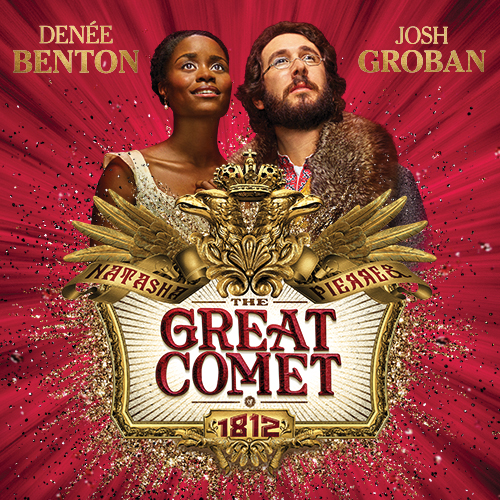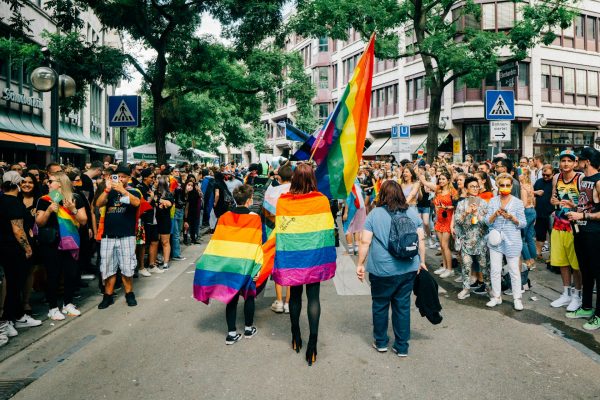In an unexpected turn of events, the Ars Nova underdog production of Natasha, Pierre, and the Great Comet of 1812 has, since is opening this week, become the most talked about piece of theater since Hamilton. The obscure musical is described as an electronic pop opera based on a small slice of Tolstoy’s War and Peace; it takes the confusing plot, myriad characters, and historical context and fusing it with a modern punk aesthetic that makes you feel like “you are at the opera” (as the opening song goes) while also being at a folky bar in Russia. Everyone–including the audience–is drinking vodka, munching on perogies, and dancing to accordion music. The show is a triumph in that it makes modern audiences fall in love with a segment of one of the largest, densest, novels ever written–not to mention the subject matter is Russian aristocrats in 1812.
This musical has had many lives off-Broadway since it was created by Dave Malloy, who wrote the music, lyrics, book, and orchestration. But the current version, directed by Rachel Chavkin, is definitively its best. The piece is somewhat immersive and was originally staged in a bar-type atmosphere, with the audience all seated at tables, and there was no clear stage, just red velvety fabric, chandeliers, and of course, the perogies. In every staging, including this one, these three elements have stayed the same. The largest obstacle this show had to overcome when transferring to Broadway, was how to make the Imperial Theatre feel like a bar. Somehow they managed.
When you walk into the Imperial Theatre, the walls are bare cement, with posters from Russian punk bands hanging up. The audience waits here as if they were going to a concert, but everyone is quickly sorted (depending on your seating) to different tunnels. From there you enter the space and realize that this is the Imperial Theatre like you have never seen it. The first few rows of the orchestra and balcony have been ripped out. There are catwalk runways that curl through the audience and onto the stage. There are staircases from the stage into the balconies. The stage has sunken pockets within it holding band members as well as spectators on bar stools, cafe tables, and large leather banquettes. The walls are covered in that red velvet and decorated with gilt mirrors and nineteenth-century portraits. Throughout the entire theater hang gorgeous modern chandeliers that look like exploding constellation. There are many bars, lots of vodka, and of course, free perogies for everyone.

Before the show even begins, this experience of finding your seat, enjoying the food and drink, and just being amazed at the transformation of the space, is unlike any other Broadway show. But once the musical actually starts the experience only gets better. Once again, this show is nothing like you ever seen before. The actors perform everywhere in the space, going into the balconies, walking through the audience, sitting on the laps of audience members onstage, handing us props, shaking our hands, and more. Somehow the show has perfected audience involvement and engagement, something most shows either ignore or are awful at.
The musical itself tells the story of Natasha, a young woman engaged to Andrey (who is off at war). However, she rapidly falls for the pretty boy Anatole, whose scheming sister Helene is married to Pierre, Natasha’s friend. Also in the mix are Sonya, Natasha’s cousin and confidante, Marya D. the young girls’ godmother, Mary, Andrey’s religious sister, and Bolkonsky, Andrey’s eccentric dad. On the surface, the plots and character names are rather confusing, but the musical embraces this, and the opening number is a direct address to the audience, telling them to look at their program when they are confused. Despite all the complication, the musical does a spectacular job at making the plot, characters, and relationships understandable and even relatable.
What is so remarkable about the cast is that almost every single performer is making their Broadway debut. The casts enthusiasm, professionalism, and perfect performances; however, do not reveal any hint of inexperience. The largest anomaly here is the imported celebrity, Josh Groban who is excellently playing the brooding and philosophical Pierre. But the rest of the cast is delightful new and is working as hard as they can in a show they are very clearly proud of. Denee Benton plays Natasha with such youth, innocence, and purity (in acting and in very impressive and emotional vocals) that you can almost see her accepting a Tony award already. Similarly, Amber Gray prays the sexual and scheming Helene with such effortless panache that she is almost challenging others to steal Best Supporting Actress. The gorgeously and hilarious Lucas Steele is a wonderful Anatole, making the audience fall in love with him as quickly as Natasha does.

Aesthetically this is one of the boldest pieces on Broadway, but also the most successful. With sets by Mimi Lien, lighting by Bradley King, and choreography by Sam Pinkleton, we are transported to an aristocratic Russian ballroom for a waltz one minute, and a modern-day, neon and strobe-light filled club the next minute–and somehow it all works. Great Comet takes you on a strange journey the amalgamates time periods and is flooded with historically accurate objects and anachronisms all at once. The costumes, designed by Tony-award winning Paloma Young, are purely extraordinary. The entire show has such a strong and bold color palette that captivates the audiences, draws us in, and creates a world where we will accept anything they wear. Indeed we do come to accept it all, as actors exchange green military tailcoats for skinny jeans, neon Nike sneakers, and leather jackets. In one scene an actress may wear a period Empire waist metallic ballgown with fur cuffs, and next to her an actor will have on tall leather boots, ripped jeans, a punk rock tee shirt, and yellow streaks in his hair. But together it all works and forms into a beautiful world that the audience never wants to leave.
Hamilton told a historical story in a new way. It challenged ideas about race and casting. It brought rap to Broadway. Great Comet does all this and more: they re-imagine an 1869 novel, have a hugely diverse cast, rap in Russian, bring electronic punk pop opera to Broadway, and completely subvert the line between audience and stage, performer and audience, time and place. Natasha, Pierre, and the Great Comet of 1812 is not the new Hamilton; it is something much different and much better. Hopefully this revolutionary musical will change the face of Broadway and elevate the standard of art, pushing all new pieces to be as bold as this one. If nothing else, this musical proves that there is a space for experimental theater on Broadway, thereby opening up a new frontier and creating a new face for Broadway.






